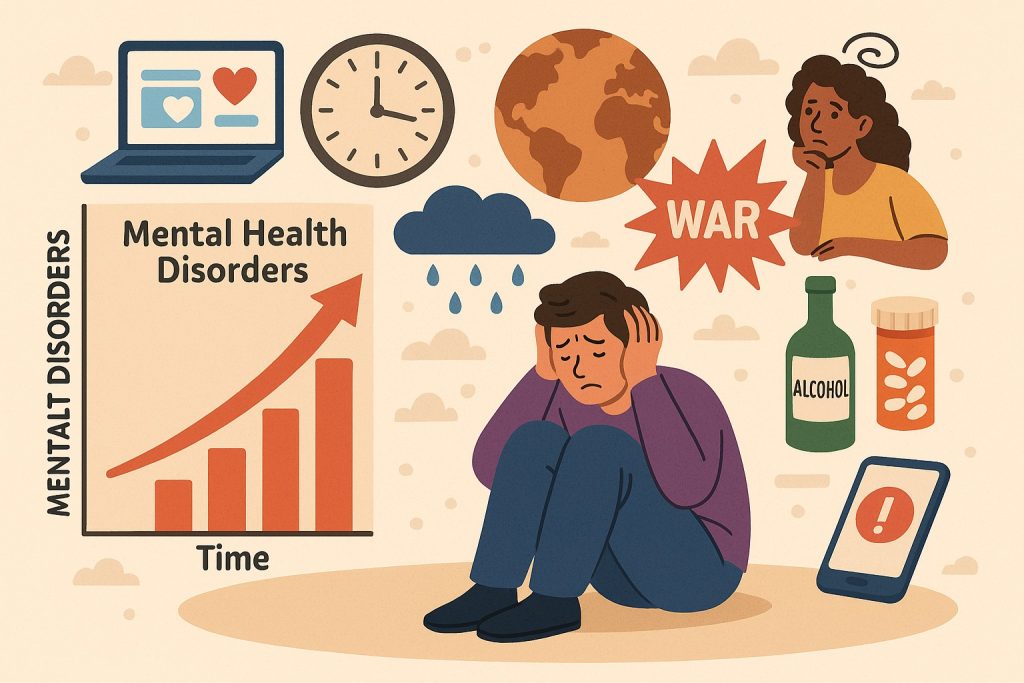Over the past half-century, the world has seen a significant increase in the prevalence of mental health disorders. Conditions like depression, anxiety, bipolar disorder, and schizophrenia are no longer rare or hidden—they now affect hundreds of millions globally. While better diagnosis and awareness play a role, many experts agree that modern life has introduced new risk factors that have amplified the burden on mental health.
How Much Have Mental Health Disorders Increased?
- According to the World Health Organization (WHO), cases of depression and anxiety have increased by over 50% since 1990.
- In 2020 alone, global rates of depression and anxiety spiked by 25%, largely due to the COVID-19 pandemic.
- Suicide remains a leading cause of death among individuals aged 15–29 worldwide.
- Disorders like ADHD, eating disorders, PTSD, and substance abuse are also on the rise—especially among youth.
These numbers reflect a growing global mental health crisis, particularly in urbanized, high-pressure societies.
What’s Behind the Rise?
1. Modern Lifestyle Changes
- Increased screen time, social media pressure, and digital isolation
- Sedentary behavior and poor sleep hygiene
- Chronic stress from work, education, or financial instability
2. Urbanization and Disconnection from Nature
- Crowded cities, noise, pollution, and lack of green space
- Less community support and more social fragmentation
3. Global Crises and Conflict
- War, displacement, inequality, and climate anxiety contribute to trauma and hopelessness
- Events like the COVID-19 pandemic exacerbated isolation and anxiety
4. Increased Awareness and Diagnosis
- More people are seeking help and receiving diagnoses, which partly explains the rise in reported cases
- Improved understanding of mental health in children, women, and marginalized populations
Who Is Most Affected?
- Young adults and adolescents show the sharpest increases, particularly in anxiety, depression, and eating disorders
- Women are statistically more likely to report mental health challenges, though men are more affected by substance abuse and suicide
- Low- and middle-income countries are hit hardest due to limited access to care
Consequences of Rising Mental Illness
- Lower productivity and economic strain on health systems
- Increased school dropouts, job loss, and homelessness
- Strain on families and caregivers
- Higher risk of chronic diseases, as mental health affects physical health
What Can Be Done?
1. Early Detection and Education
- Incorporate mental health education in schools
- Normalize mental health screenings like blood pressure checks
2. Accessible and Affordable Care
- Increase investment in community mental health services
- Train more mental health professionals, especially in rural and low-income areas
3. Supportive Policies and Workplaces
- Promote mental wellness at work and in public life
- Encourage flexible schedules, paid mental health leave, and anti-stigma campaigns
4. Self-Care and Community Support
- Promote regular exercise, nutrition, mindfulness, and social connection
- Encourage peer support groups and family-based care
Glossary
- Mental health disorder — A medical condition affecting mood, thinking, or behavior
- Depression — A mood disorder causing persistent sadness, fatigue, and loss of interest
- Anxiety — Excessive worry or fear, often interfering with daily activities
- PTSD — A condition triggered by trauma, leading to flashbacks and anxiety
- Stigma — Negative societal judgment that discourages people from seeking help


